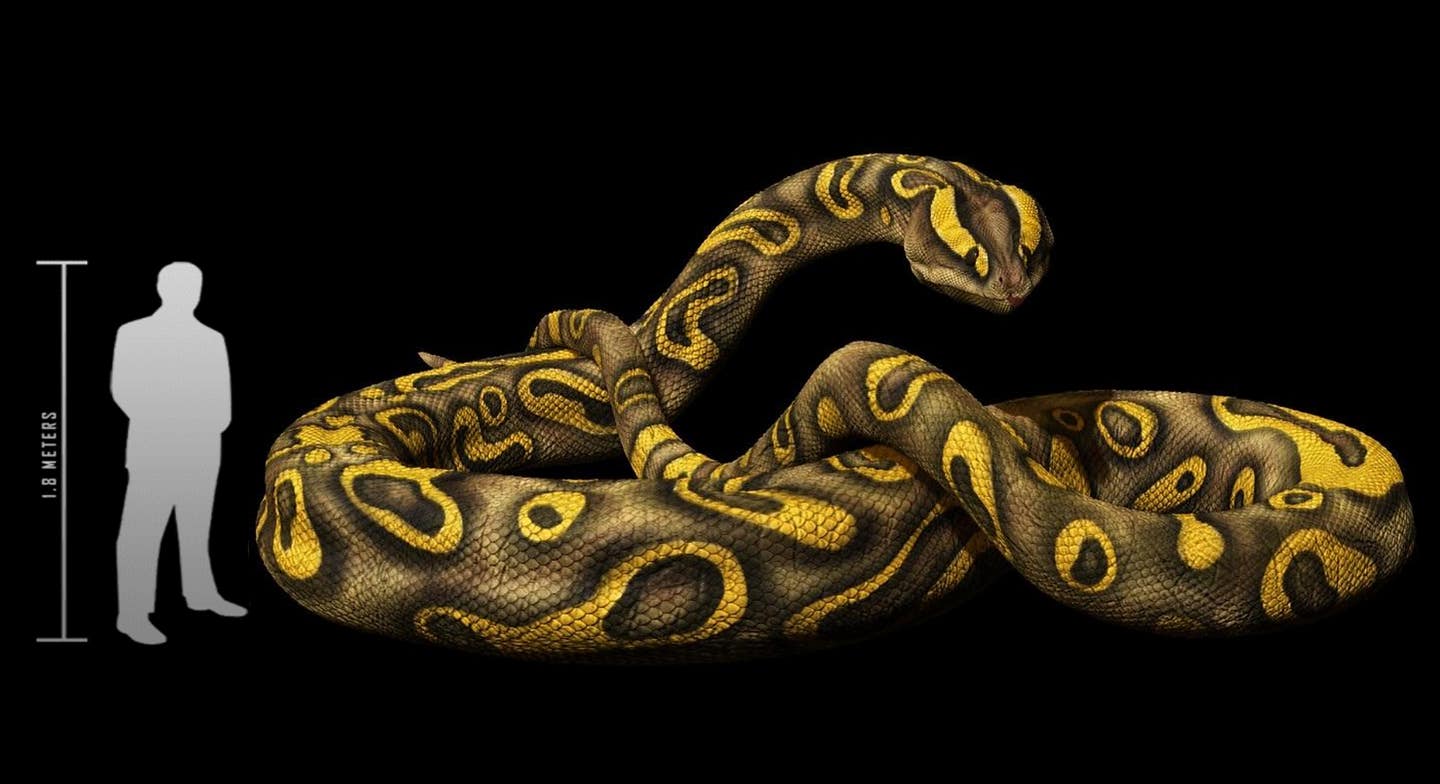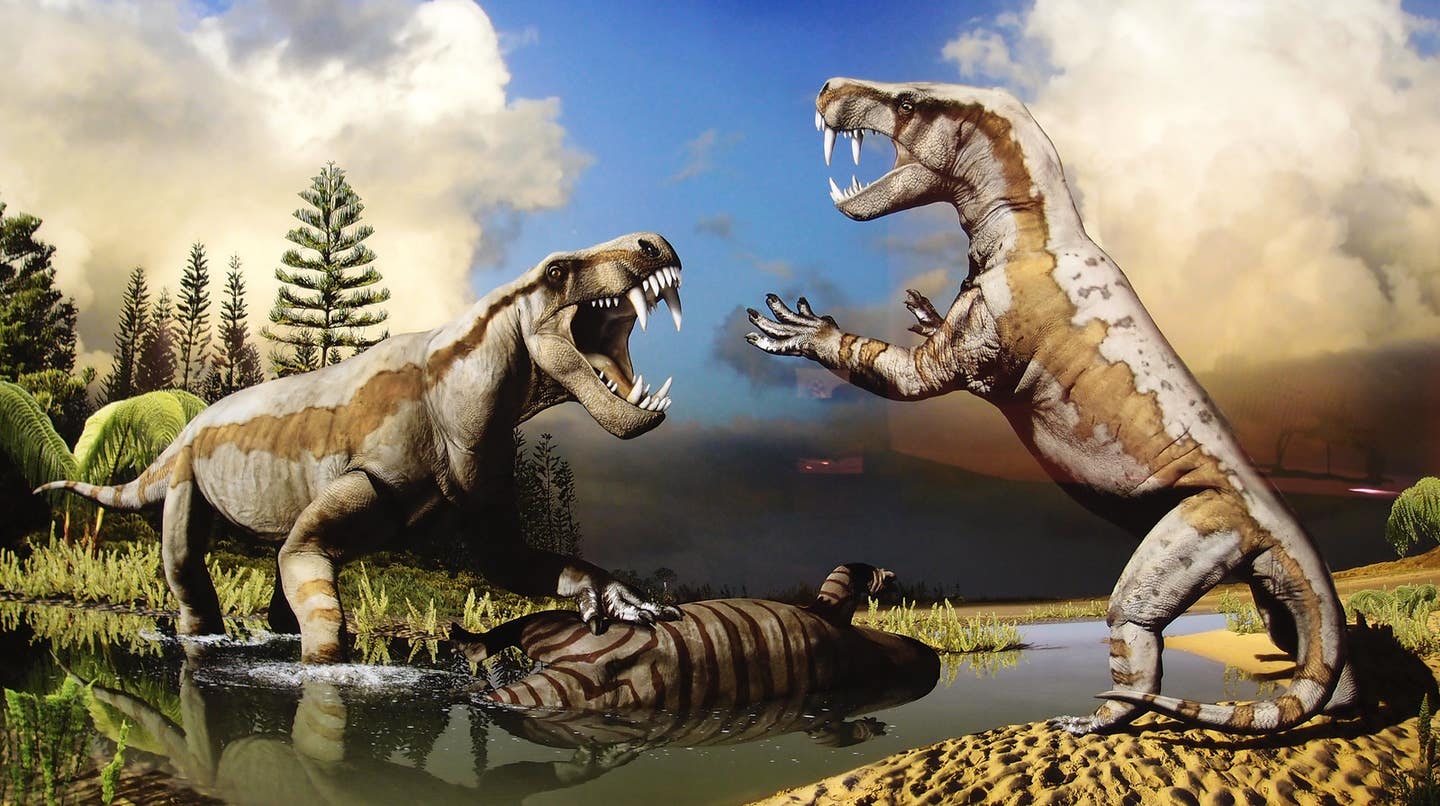Colossal snake measuring over 50 feet long found in India
Scientists have unearthed the fossilized remains of an enormous snake, believed to be one of the largest of its kind ever found.

Measuring a staggering 50 feet long, this prehistoric giant, Vasuki indicus, is among the largest snakes ever found. (CREDIT: CC BY-SA 4.0)
In a groundbreaking discovery, scientists in India have unearthed the fossilized remains of an enormous snake, believed to be one of the largest of its kind ever found. This colossal creature, dubbed Vasuki indicus, stretches an astonishing 50 feet in length, dwarfing its modern-day relatives like pythons.
The findings, published in the journal Scientific Reports, shed light on the prehistoric biodiversity of the Indian subcontinent.
Researchers hailing from the Indian Institute of Technology Roorkee stumbled upon a remarkably well-preserved segment of the snake's vertebral column. Dr. Rajesh Kumar, lead author of the study, expressed excitement over the find, describing it as "excellently preserved."
Their analysis, based on 27 vertebrae, conclusively identified the specimen as Vasuki indicus, a species long extinct.
The name "Vasuki" draws inspiration from Hindu mythology, specifically the serpent Vāsuki, entwined around the neck of Lord Shiva, a central figure in Shaivism. This choice reflects the cultural significance of snakes in Indian folklore.
Insights gleaned from the fossil suggest that Vasuki indicus was not merely a colossal serpent, but also a formidable predator. Researchers speculate that its massive size rendered it sluggish, ruling out the possibility of it actively hunting for prey.
Related Stories
Instead, they posit that Vasuki likely employed ambush tactics, similar to modern pythons, relying on constriction to subdue its victims.
Describing the specimen's physical characteristics, the study highlights its fully developed stature and robust build. With a broad, cylindrical body, Vasuki indicus could have tipped the scales at a staggering 2,200 pounds, making it a true behemoth of the ancient world.
Comparisons with other extinct snakes further underscore Vasuki indicus's extraordinary dimensions. While the famed Titanoboa shares a similar length, stretching between 45 to 50 feet, Vasuki's girth sets it apart. This places it firmly in contention for the title of the largest snake ever discovered.
Delving into the evolutionary history of these colossal serpents, researchers note their lineage within the Madtsoiidae family. Spanning approximately 100 million years across Africa, Europe, and India, these ancient reptiles left an indelible mark on Earth's ecosystems.
However, Vasuki indicus occupies a unique niche within this lineage, originating specifically from the Indian subcontinent during a bygone era, approximately 56 to 34 million years ago.
The discovery of Vasuki indicus serves as a testament to India's rich paleontological heritage. Dr. Kumar emphasizes the importance of such findings in unraveling the mysteries of prehistoric life, stating, "Each fossil unearthed offers a glimpse into the distant past, enriching our understanding of Earth's ancient inhabitants."
The unearthing of Vasuki indicus represents a significant milestone in the annals of paleontology. As scientists continue to delve into the depths of Earth's history, discoveries like this illuminate the fascinating diversity of life that once thrived on our planet.
The longest snakes in the world today
Reticulated Python (Malayopython reticulatus)
The reticulated python is the longest snake in the world, reaching lengths of up to 30 feet (9 meters). Native to Southeast Asia, it thrives in rainforests, grasslands, and woodlands. Its striking pattern of dark and light bands gives it the name "reticulated." This non-venomous constrictor preys on mammals and birds, and while there are rare reports of attacks on humans, these pythons typically avoid contact.
Green Anaconda (Eunectes murinus)
While the green anaconda holds the title of the heaviest snake, it can still grow up to 29 feet (8.8 meters) long. Found in South America, particularly in the Amazon and Orinoco basins, this massive snake is semiaquatic, spending much of its time in swamps and rivers. Its bulky frame allows it to overpower large prey like capybaras, deer, and even caimans through constriction.
Burmese Python (Python bivittatus)
This large python can grow up to 23 feet (7 meters) long and is native to Southeast Asia. It inhabits marshes, grasslands, and open forests. Known for being an invasive species in the Florida Everglades, the Burmese python has a voracious appetite, feeding on birds, mammals, and even alligators. Its popularity in the pet trade has contributed to its spread outside of its native range.
African Rock Python (Python sebae)
Africa's largest snake, the African rock python, can reach lengths of up to 20 feet (6 meters). It is found across sub-Saharan Africa and can live in a variety of habitats, including savannas, forests, and grasslands. Known for its aggressive nature when threatened, this constrictor preys on large animals such as antelopes and warthogs.
Indian Python (Python molurus)
Closely related to the Burmese python, the Indian python can grow up to 20 feet (6 meters) long. It inhabits the forests, grasslands, and swamps of the Indian subcontinent. This species is revered in Indian culture, often depicted in folklore. It is a powerful constrictor, preying on small mammals, birds, and reptiles.
Amethystine Python (Morelia amethistina)
Also known as the scrub python, the amethystine python can grow up to 19 feet (5.8 meters) and is native to Australia, Papua New Guinea, and parts of Indonesia. It is named for its iridescent scales that shimmer with a purple hue in the light. This python is an excellent climber and hunter, preying on birds, bats, and small mammals.
King Cobra (Ophiophagus hannah)
The king cobra is the longest venomous snake in the world, capable of reaching lengths of up to 18 feet (5.5 meters). Native to Southeast Asia and parts of India, this snake is known for its potent neurotoxic venom and characteristic hood. Despite its intimidating size, it primarily feeds on other snakes, including venomous species.
Boa Constrictor (Boa constrictor)
The boa constrictor can grow up to 13 feet (4 meters) long and is native to tropical regions of Central and South America. While not as long as some pythons, it is an iconic constrictor species that uses its muscular body to subdue prey. Boas are solitary hunters and have been known to live in a variety of habitats, from rainforests to arid regions.
Yellow Anaconda (Eunectes notaeus)
Though smaller than its relative, the green anaconda, the yellow anaconda can still grow up to 13 feet (4 meters) long. It is found in the swamps and marshlands of South America, particularly in Paraguay and Argentina. Like other anacondas, it is semiaquatic and preys on aquatic animals, such as fish and birds.
Olive Python (Liasis olivaceus)
The olive python, native to Australia, can reach lengths of up to 13 feet (4 meters). It gets its name from its smooth, olive-colored scales. This python prefers rocky outcrops and gorges, where it can find prey like wallabies, bats, and small mammals. It is non-venomous and constricts its prey to kill it.
These snakes represent the most impressive lengths in the world of reptiles, showcasing a diversity of habitats, behaviors, and adaptations for survival.
Note: Materials provided above by The Brighter Side of News. Content may be edited for style and length.
Like these kind of feel good stories? Get The Brighter Side of News' newsletter.
Joseph Shavit
Head Science News Writer | Communicating Innovation & Discovery
Based in Los Angeles, Joseph Shavit is an accomplished science journalist, head science news writer and co-founder at The Brighter Side of News, where he translates cutting-edge discoveries into compelling stories for a broad audience. With a strong background spanning science, business, product management, media leadership, and entrepreneurship, Joseph brings a unique perspective to science communication. His expertise allows him to uncover the intersection of technological advancements and market potential, shedding light on how groundbreaking research evolves into transformative products and industries.



